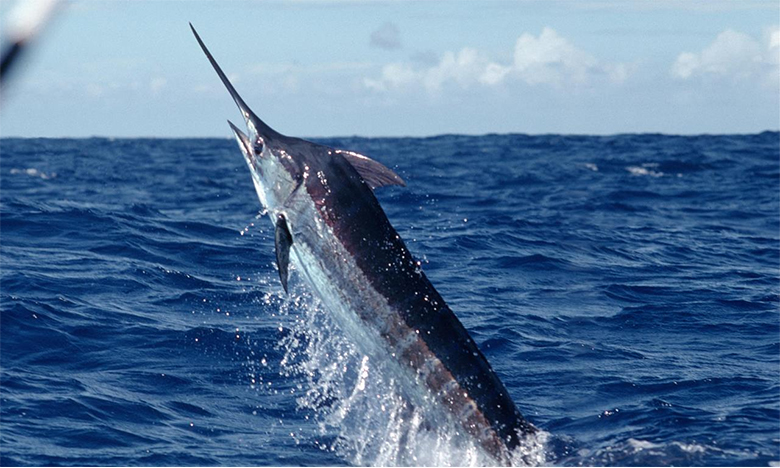Houston oil man Alfred Glassell Jr. landed a 1,560-pound black marlin off the coast of Cabo Blanco in northern Peru on August 4, 1953, bagging himself a world record that stands to this day. He hooked the fish at the once-legendary underwater canyon known as Marlin Boulevard and eventually landed it after fighting the sea beast for nearly two hours. Footage of the fish leaping out of the water in an attempt to get free of the hook was used in the 1960 film of Ernest Hemingway’s classic The Old Man and the Sea.
During the spot’s heyday, A-listers like Marilyn Monroe, John Wayne, Humphrey Bogart, Joe di Maggio and Ernest Hemingway flocked to Cabo Blanco in the hopes of landing the big one. Hemingway spent six weeks at the club in 1956 and only managed to reel in a 910-pounder. Kimberley Wiss came closest to breaking Glassell’s record, with 1,525- and 1,540-pound specimens — notably still a women’s record — in 1954. Around the same time, one of the commercial fishing boats harpooned a 2,250-pound brute of a marlin, and there were always numerous tales of the one that got away. Nowadays both the celebrities and the “granders” (1,000-pound marlin) are long gone, and the once elegant Cabo Blanco Fishing Club is falling apart, windowless; both the bar and the swimming pool are bone-dry.
"IT WAS WITHOUT ANY QUESTION THE BEST PLACE IN THE WORLD TO CHASE BIG BLACK MARLIN."
It used to be “the spot,” says Captain Norm Isaacs, a big-game fisherman who has hosted his own shows on Fox and ESPN. He’s been living and fishing in Cabo Blanco for the past three years as part of an effort to resurrect the region’s sport-fishing industry. “It was without any question the best place in the world to chase big black marlin,” Isaacs says. In 1954 alone, an astounding 16 granders were landed and in the ’50s and early ’60s, Cabo Blanco produced a total of 16 different world records for everything from tuna to roosterfish. What made it even more special was that most of these fish were caught within a couple of miles of shore.
Local fishermen have plied the waters off Cabo Blanco, where the cold Humboldt Current meets the warm Pacific Current, for generations. But their small boats and primitive equipment mean that they seldom catch marlin — and when they do it is invariably with a harpoon. Since the very beginning, only outsiders have focused on catching the granders on rod and reel. The first such outsider, as detailed by writer S. Kip Farrington Jr. in Fishing the Pacific, was Canadian businessman Thomas G. Stokes, who caught a 601-pounder in 1935 and a 712-pounder a year later. Over the next decade, only a handful of others fished at Cabo Blanco, largely due to the chaos of World War II.
But from 1948 onward, Farrington, Glassell and the Peruvian fisherman Enrique Pardo set about exerting their considerable influence on the Lobitos Oil Company to donate them the land on which to build a clubhouse. Between April 1951 and August 1953, 21 men were invited to join, 16 of whom accepted. “One man offered me as much as $50,000 to get him in,” Farrington wrote. “But the aim was to restrict membership to a particularly fine crowd — above all a congenial group.”
The first clubhouse opened on January 1, 1953, and it was just a humble affair with room enough for 10 guests. Barely a year later, it was made larger and more luxurious, sporting what Farrington described as “the finest tackle room ever built” and “beautiful outside dining facilities.” More important than the clubhouse was the crew — nine local men handpicked from the commercial fleet — and three made-to-order boats from Wedgeport, Nova Scotia. The Miss Texas, the boat on which Glassell landed his record fish, has recently been lovingly restored by Isaacs’ employers and it is, he notes, “roly-poly as the dickens.”
“I’ve never fished any place in the world, ever, that had that abundance of life of all sorts,” Glassell told sport-fishing writer Doug Olander before his death in 2008. “The entire spectrum of life in the sea just went through there like a parade.”
No one knows why or precisely when the big fish disappeared, because in 1970, “they kicked all the gringos out and the government took over,” Isaacs says. But really the fishing had been in decline for a few years before that. The two most commonly cited causes are overfishing of anchovetas (a tiny fish near the bottom of the food chain) and a change in the currents due to El Niño. But this doesn’t really explain why the Banco de Mancora — some 30 miles to the north — just had one of its best marlin seasons ever.
“I am absolutely convinced that Cabo Blanco will wake up sometime,” Isaacs says. “I’m not sure when or for how long. But I’m pretty certain it’ll happen.”

